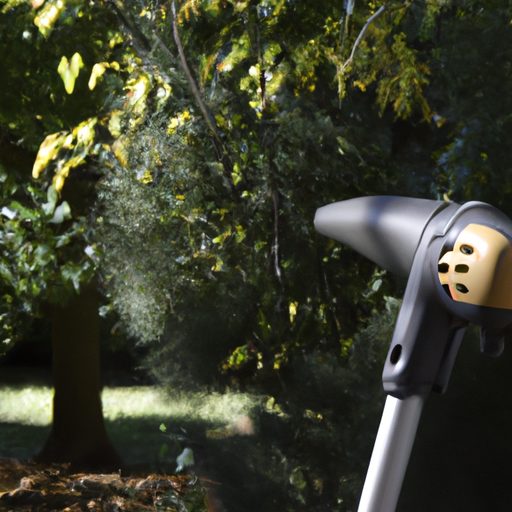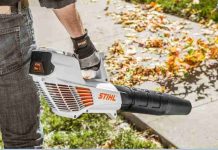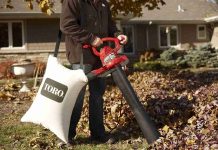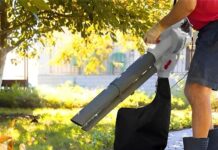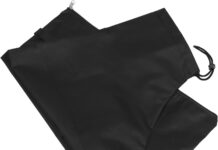Ladies and gentlemen, have you ever found yourself in a situation where the sounds of nature were drowned out by the deafening roar of a leaf blower? We’ve all been there, yearning for a peaceful moment in our own backyards while battling with the decibels of these necessary yet noisy machines. But fear not, dear friends, for today we embark on a quest to answer the age-old question: is there such a thing as a quiet leaf blower? Join us as we explore the possibilities and uncover the secrets behind a whisper-quiet solution to your leaf-blowing woes.
Is There Such A Thing As A Quiet Leaf Blower?
Noise Pollution and Leaf Blowers
As homeowners, we understand the importance of maintaining our yards and keeping them clean and presentable. Leaf blowers have become an essential tool in this endeavor, helping us clear away fallen leaves and debris quickly and efficiently. However, one of the major drawbacks of leaf blowers is the noise they generate, often causing a significant amount of noise pollution in our neighborhoods. The constant whirring and engine sounds of traditional leaf blowers can be disruptive, not only to us but also to our neighbors and the overall tranquility of our communities.
The Need for Quiet Leaf Blowers
Recognizing the negative impact of noise pollution, the need for quieter alternatives to leaf blowers has become increasingly apparent. Many municipalities have implemented noise ordinances to regulate the use of leaf blowers, limiting their use to certain hours of the day or even banning them altogether. As a result, manufacturers have been prompted to develop quieter leaf blowers that comply with these regulations while still prioritizing performance and efficiency.
Current Noise Levels of Leaf Blowers
Traditional gasoline-powered leaf blowers typically produce noise levels ranging from 70 to 75 decibels (dB), which is equivalent to the noise level of a busy city street or a vacuum cleaner. Electric leaf blowers, although generally quieter, can still reach noise levels of around 60 to 65 dB, which can still be disruptive to our quiet neighborhoods. These noise levels can not only affect our own well-being but also have adverse effects on mental health, sleep quality, and concentration in both adults and children.
Challenges in Developing Quiet Leaf Blowers
Designing quiet leaf blowers poses several challenges for manufacturers. One of the main obstacles is finding a balance between reducing noise levels and maintaining sufficient power and blowing capacity. Leaf blowers rely on powerful motors to generate enough airflow to effectively remove leaves and debris, and reducing noise can sometimes result in a compromise in performance. Additionally, the compact size of leaf blowers makes it difficult to incorporate effective noise reduction measures without compromising the functionality and maneuverability of the tool.
Advancements in Noise Reduction Technology
Despite these challenges, advancements in noise reduction technology have allowed for the development of quieter leaf blowers that offer both performance and reduced noise levels. Several techniques and innovations have contributed to this progress, including:
1. Noise Muffling Techniques
Manufacturers have employed various noise muffling techniques to minimize the sound emitted by leaf blowers. These may include the use of insulated casings, sound-absorbing materials, and specially designed air intake and exhaust systems. By reducing the vibration and airflow noise, these muffling techniques help to create a more enjoyable and less disruptive user experience.
2. Acoustic Engineering
The field of acoustic engineering has played a crucial role in improving the quietness of leaf blowers. By carefully analyzing and optimizing the different components of leaf blowers, such as the airflow path, fan design, and motor configuration, engineers have been able to minimize noise generation and maximize performance. Advanced computer simulations and modeling techniques have made it possible to predict and fine-tune the acoustic characteristics of leaf blowers during the design phase.
3. Design Modifications
Innovative design modifications have contributed to reducing noise levels without compromising functionality. For example, the placement of the motor and fan within the leaf blower can be optimized to minimize noise transmission to the user and surrounding environment. Additionally, the addition of baffles and chambers within the leaf blower’s housing can further dampen noise and prevent sound waves from escaping the device.
4. Electric vs. Gasoline Leaf Blowers
Electric leaf blowers, powered by rechargeable batteries or connected to an electrical outlet, have gained popularity due to their quieter operation compared to their gasoline counterparts. The electric motors used in these leaf blowers produce less noise and vibration, resulting in a more peaceful user experience. Furthermore, advancements in battery technology have increased the runtime and power of electric leaf blowers, making them a viable alternative for homeowners seeking a quieter option.
The Role of Regulations and Standards
To address the issue of noise pollution caused by leaf blowers, both local governments and industry organizations have implemented regulations and standards to ensure the development and use of quieter leaf blowers.
1. Local Noise Ordinances
Many cities and towns have established noise ordinances that restrict the use of leaf blowers during certain hours or limit the noise levels emitted by these devices. These ordinances aim to strike a balance between maintaining a clean environment and ensuring the well-being of residents. By adhering to these regulations, homeowners can contribute to the reduction of noise pollution in their communities.
2. Certification and Testing
Industry organizations, such as the American National Standards Institute (ANSI) and the European Noise Directive, have developed certification programs and testing methods to evaluate the noise emission of leaf blowers. These standards help manufacturers design quieter leaf blowers and empower consumers to make informed choices based on the noise ratings and decibel levels provided.
3. Manufacturers’ Efforts
Many manufacturers have made concerted efforts to produce quieter leaf blowers that comply with local regulations and meet consumers’ demands for less noisy tools. These companies invest in research and development to incorporate noise reduction technologies into their designs. By actively participating in the development of standards and implementing noise reduction measures, manufacturers demonstrate their commitment to providing quieter alternatives to the market.
Benefits of Quiet Leaf Blowers
The availability of quiet leaf blowers brings many benefits to homeowners and communities, extending far beyond noise reduction. Let’s explore some of these advantages:
1. Enhanced User Experience
Quiet leaf blowers provide a more pleasant and enjoyable user experience. By minimizing noise levels, homeowners can engage in yard maintenance without disturbing their own peace or that of their neighbors. Users can focus on the task at hand without the constant annoyance of loud engine noises, allowing for a more relaxed and efficient cleanup process.
2. Reduced Environmental Impact
Traditional gasoline-powered leaf blowers contribute to air and noise pollution, emitting harmful pollutants and greenhouse gases. Choosing a quiet leaf blower, particularly an electric model, significantly reduces emissions and helps mitigate the impact on the environment. By opting for a quieter, more environmentally-friendly option, homeowners can contribute to creating a cleaner and healthier neighborhood.
3. Better Neighborhood Relations
Excessive noise from leaf blowers can strain neighborly relationships and create tension within communities. By using a quiet leaf blower, homeowners can foster positive relationships with their neighbors, as the reduced noise levels minimize disturbances and promote harmony. Good relationships with neighbors can contribute to a more cohesive and enjoyable living environment.
Consumer Options for Quiet Leaf Blowers
As the demand for quieter leaf blowers continues to rise, consumers now have a wide range of options available to them. Manufacturers have recognized this growing market niche and are offering innovative and quiet leaf blowers with various features and price ranges.
1. Top Rated Quiet Leaf Blowers
Several brands have gained recognition for producing top-rated quiet leaf blowers. These models prioritize noise reduction without compromising performance. Some popular options include the Greenworks PRO 80V, EGO Power+ 580 CFM, and Worx Turbine 600.
2. Noise Ratings and Decibel Levels
When choosing a quiet leaf blower, consumers can refer to the noise ratings and decibel levels provided by manufacturers. Comparing these ratings can help homeowners select a leaf blower that aligns with their noise tolerance and local regulations. Ideally, seek leaf blowers with noise levels below 65 dB for a quieter experience.
3. Price Range and Features
Quiet leaf blowers are available across a range of price points, allowing homeowners to find an option that suits their budget. Consumers can consider additional features such as battery life, blowing power, and ease of use when making their purchasing decision. It is essential to find a balance between noise reduction and the necessary functionality required for efficient yard maintenance.
Future Outlook for Quiet Leaf Blowers
The future looks promising for quiet leaf blowers as advancements in noise reduction technology continue to evolve. As the demand for quieter tools increases, manufacturers will likely invest more resources in research and development to create even quieter and more efficient leaf blowers. Ongoing collaboration between industry organizations, governments, and manufacturers will further drive the innovation of noise reduction techniques and support sustainable yard maintenance practices.
Conclusion
In conclusion, the advent of quiet leaf blowers brings us hope for a more peaceful and environmentally-friendly way of maintaining our yards. By prioritizing noise reduction, manufacturers, governments, and consumers can work together to create cleaner and quieter communities. With the benefits of enhanced user experience, reduced environmental impact, and improved neighborhood relations, quiet leaf blowers offer a win-win solution for homeowners and their communities. Consider selecting a quiet leaf blower for a better, more enjoyable home maintenance experience.

